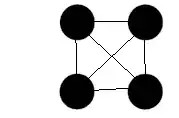First of all, by symmetry, it suffices to show that the first two qubits are entangled. Swapping any two qubits brings this state back to itself, so if the first two subsystems are entangled, then each pair of them is entangled.
Notice that your state can be written as follows: $$\lvert\psi\rangle = \tfrac{1}{\sqrt 2}\lvert\Psi_+\rangle\lvert 00\rangle + \tfrac{1}{\sqrt 2}\lvert 00\rangle\lvert \Psi_+\rangle$$ so that it has the following density matrix: $$\lvert\psi\rangle\langle\psi\rvert = \begin{align}&\tfrac{1}{2}\lvert\Psi_+\rangle\langle\Psi_+\rvert \otimes \lvert 00\rangle\langle 00\rvert \\ &+ \tfrac{1}{2}\lvert 00\rangle\langle 00\rvert \otimes \lvert \Psi_+\rangle\langle \Psi_+\rvert \\ &+ \tfrac{1}{2}\lvert\Psi_+\rangle\langle 00\rvert \otimes \lvert 00\rangle\langle \Psi_+\rvert \\ &+ \tfrac{1}{2}\lvert 00\rangle\langle\Psi_+\rvert \otimes \lvert\Psi_+\rangle\langle 00\rvert\end{align}$$
Let’s take the trace of this state with respect to the third and fourth qubits, representing the mixed state we would get by throwing out those qubits. Performing this computation on your state $\lvert\psi\rangle$ gives us the following:
$$\text{tr}_{34} \lvert\psi\rangle\langle\psi\rvert = \tfrac{1}{2}\lvert\Psi_+\rangle\langle\Psi_+\rvert + \tfrac{1}{2}\lvert 00\rangle\langle 00\rvert$$
which represents a statistical combination consisting of $50\%$ unentangled pairs of qubits in the state $\lvert 0\rangle$, and $50\%$ maximally entangled pairs of qubits in the Bell state $\lvert\Psi_+\rangle$.
Can you verify that this mixed state is entangled? If so, you'll have shown that each pair of subsystems in the original 4-part system is entangled.
